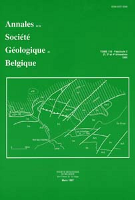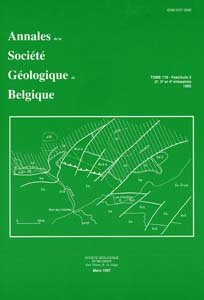- Home
- Volume 93 (1970)
- Fascicule 3
- Le complexe éruptif du Rogaland méridional (Norvège). Signification pétrogénétique de la farsundite et de la mangérite quartzitique des unités orientales; arguments géochronologiques et isotopiques
View(s): 375 (0 ULiège)
Download(s): 192 (3 ULiège)
Le complexe éruptif du Rogaland méridional (Norvège). Signification pétrogénétique de la farsundite et de la mangérite quartzitique des unités orientales; arguments géochronologiques et isotopiques

Résumé
La possibilité de l'existence d'une relation génétique entre la farsundite typique et les mangérites du lopolithe de Bjerkrem-Sogndal (Norvège méridionale) est ré-étudiée à la lumière des résultats géochronologiques obtenus sur zircons et sphènes et en fonction des valeurs des rapports isotopiques du strontium de l'apatite et du plomb du feldspath.
La farsundite semble illustrer le cas le plus fréquent présenté par les granites orogéniques : (87Sr/86Sr)0 est voisin de 0.71 et la composition isotopique du plomb du feldspath se situe dans le « domaine général » correspondant aux roches ignées de 1 milliard d'années. Les mangérites révèlent un excès de 87Sr et de 206Pb.
Une origine commune reste admissible pour ces deux roches, mais elle impliquerait une assimilation de matériau métadétritique pour la mangérite et métavolcanique pour la farsundite.
L'excès de 206Pb constaté dans les mangérites pourrait être caractéristique du « magma plagioclasique » de P. Michot et résulter d'une interaction manteau-croûte au niveau des orogènes.
Abstract
The possibility of a genetic relationship between the typical farsundite and the mangerites of the Bjerkrem-Sogndal lopolith (southern Norway) is re-examined, taking into account geochronological data concerning zircons and sphenes, and isotopic data on apatite strontium and feldspar lead.
The farsundite is a partly concordant, partly discordant body of hornblende-bearing granodiorite with, towards the west near the mangerite outcrop, a charnokitic facies. This situation, together with petrographic evidence of early feldspar formation in both rocks, suggests some genetic relationship.
The radiometric dates from zircons suggest a slightly earlier emplacement time for the farsundite (993 18 m.y.) than for the mangerites (967 12 m.y.). Alternatively, this small difference could be due to the presence of zircon xenocrysts in the farsundite.
Both rock types appear to be internally homogeneous as regards lead and strontium isotopes. However, significant differences exist between the two rock types. The farsundite seems to conform to the “normal” — or at least the most commonly encountered composition for orogenic granites: (87Sr/86Sr)0 close to 0.71, and feldspar lead lying within the “main range” defined for granitic rocks aged 1.0 b.y. The mangerites exhibit an excess of 87Sr and of 206Pb.
A common origin for the two rocks remains possible. But, if this is so, it would seem to imply assimilation of metasedimentary material in one case (mangerite) and of metavolcanics in the other (farsundite). The other possibilities are that the farsundite is related to the earlier, large Egersund-Ogna massif which is mainly anorthositic in composition, or that it does not belong to the anorthosite clan.
The excess of 206Pb found in the mangerites agrees with the results of Zartman and Wasserburg on some similar rocks in the Adirondacks. This situation may characterize the “plagioclasic magma” of P. Michot, resulting from some type of mantle-crust interaction in orogenic belts.






